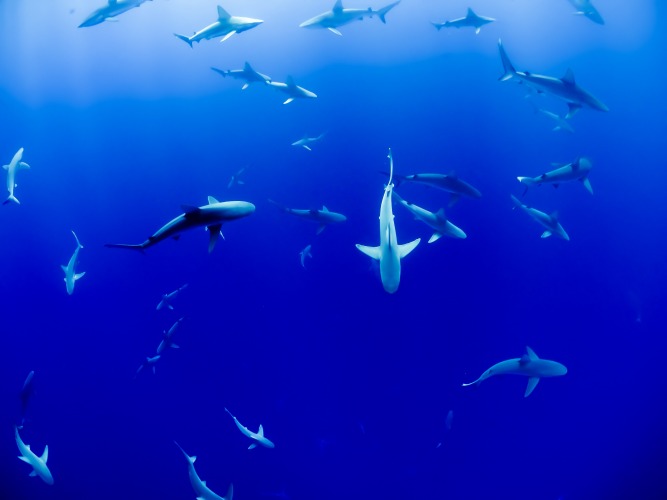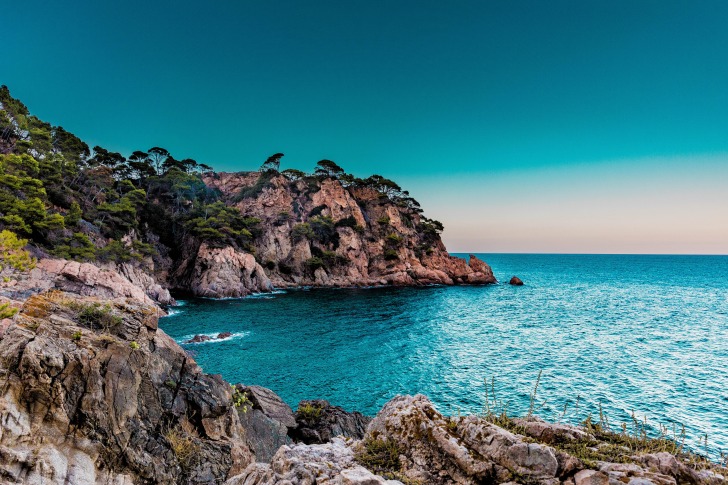Spain is not a location that is typically associated with a sizable number of sharks but in reality?
There are often more sharks in Spain than you would think.
In fact, there are roughly 50 different species of shark cataloged along the Spanish coasts.
For residents and visitors of Spain, sightings are more likely in the Cantabrian Sea and the Atlantic Ocean.
The colder waters are more to the sharks’ liking.
The Mediterranean waters are also favored by the sharks but this is not a country that is widely associated with any sort of deadly attack.
Let’s take a closer look at the sharks of Spain and how their presence affects everyday activities.
Contents
So… Are There Sharks in Spain?
The answer here is a resounding yes.
However, it is important to remember that the scary shark tropes that have been reinforced by various movies and television shows can be ignored here.
Sharks are not inherently vicious creatures who are swimming around looking for humans to snack on.
In fact, they are only known to attack when they have been disturbed in some way.
There are over 50 species that can be found on the coast and 47 species are associated with the Mediterranean Sea.
When you take into account the sheer number of sharks that are present in Spain, the lack of shark attacks paints a relieving picture when it comes to human safety.
According to the International Shark Attack Archives, there have only been three documented shark attacks in Spain since 1996.
In 1996, a windsurfer suffered a bite to their foot that led to an amputation.
The second attack did not take place until several years later.
A doctor was assaulted by a shark 200 meters from the coastline.
Amazingly, the good doctor was able to make himself a tourniquet and he survived the injuries.
The most recent shark attack took place ten years ago.
In 2012, a fisherman was attacked in the Bay of Biscay.
They were bitten on the arm by a shark while they were fishing but the injuries were not fatal.
Not only were none of these injuries fatal but injuries were minimal, as compared to the fears that have been stirred up by various forms of media.
While there is no shortage of shark species that can be found in Spain, we are going to focus on the most commonly sighted species.
This will give visitors and residents a clearer picture of what they can expect.
Great White Shark
These sharks are typically spotted in the Mediterranean.
While attacks can be fatal, there is no need for Spanish residents and visitors to worry.
Most of these attacks take place in other countries, whether we are discussing the Asian coastlines or the Pacific coast of the United States.
Great white attacks are rarer for European countries.
Tiger Shark
They are not often seen on the Spanish coastlines but they are present and they can be dangerous.
Now that climate change has become a bigger issue, Spanish residents and visitors must remain on the lookout.
Sharks like these, which are typically associated with tropical waters, are going to become more of a presence in European territories.
Blue Shark
These sharks are commonly seen all over the world.
They are seen in Spain and in the Mediterranean.
The blue shark can reach a length of 4 meters and can weigh up to 200 kilograms.
They are fast hunters who have been known to capsize smaller boats.
In most instances, they are usually looking to consume larger fish.
Large spotted catshark
From Israel to Spain, these sharks are often spotted in the Mediterranean but that does not mean that swimmers will have nothing to worry about.
It is rare to hear of any of these fish launching an attack on a swimmer but fishermen will want to be aware.
If these sharks are caught accidentally, they can react in a violent manner.
Copper shark
These sharks are more common in southern Spain than in the northern region.
While there are no violent attacks to speak of when it comes to Spain, copper sharks have been known to react viciously in other regions of the world.
Basking shark
The basking shark is the largest that will be found in Spain.
These sharks will grow to a length of at least 10 meters long.
They do not pose any threat to humans, though.
Their lack of teeth and docile nature make them more than safe to share the waters with.
They are not predatory fish by nature.
Oceanic whitetip shark
These sharks are more dangerous in nature and are often found off the Spanish coast.
They are usually found in the Atlantic Ocean and are not likely to spend much time in the smaller seas that have been mentioned above.
Do not swim with smaller wounds, as these sharks have a very keen sense of smell, especially when blood is involved.

Is it Safe to Swim in Spain?
While there are precautions that should be taken, it is safe to swim in Spain.
There are colored flags for each body of water that will let you know about the potential risk levels.
Much like traffic lights, the flags are chosen according to red/green/yellow.
Red means to avoid the water at all costs, yellow means to proceed with caution, and green means that you are safe.
If there are calm patches of water with waves on either side, this means that there are rip currents to watch out for.
Any swimmer who happens to come across one should not swim against it.
Swim to the side where the waves are currently breaking.
Jellyfish blooms must also be avoided, owing to their very painful stings.
While it is important to be wary, there is no reason to be afraid of the Spanish beaches.
All you need to do is take a few common sense precautions.
From there, you and your loved ones will be able to enjoy the waters with no issues at all.
Interesting Shark Facts in Spain
The sheer number of sharks in Spain may cause some to believe that they are in constant danger but the attack numbers do not bear this out.
Within the past 30 years, there have only been three shark attacks, none of which were fatal.
This is especially amazing when you stop to consider the sheer number of species that reside in Spain.
There are at least 50 species located off the coastline and 47 are associated with the Mediterranean Sea alone.
With the sizable number of people who bathe in this sea each year, visitors would be forgiven for thinking shark attacks were common.
That does not mean that massive sharks are not spotted.
This past May, swimmers were ushered out of the water by an on-duty lifeguard because of the presence of a 5-foot-long blue shark.
Their appearance caused a massive panic but the shark did not seem interested in the humans who were nearby.
It is likely that the shark was disoriented, as it drifted about lazily before returning to deeper waters without causing any bodily harm.
The majority of sharks reside in the oceans but there are some species that are able to travel through and reside in freshwater locations.
For Spanish residents and visitors, there are not many freshwater species that they need to be concerned with.
Australia and Asia are far more common locations for these sharks.
This is because the majority of sharks are not able to survive in freshwater conditions.
Some of these sharks are able to use freshwater as a means of migration but they are not able to make a habitat there because of the colder temperatures.
In fact, there are specific temperatures that must be maintained in order for the average shark to survive in saltwater.
Now that climate change is having a greater effect on these aspects, Spanish residents and visitors must be aware of different species.
As long as the waters maintain a temperature of 75 to 84 degrees Fahrenheit, saltwater sharks are more than happy to reside there.

3 Safety Tips for Swimming in Shark-Infested Waters
1. Research Local Beaches
If you are spending time in Spain and are not familiar with the terrain, take a moment to research the local beaches.
This will tell you if you are placing yourself at any sort of risk.
There are certain locations where shark sightings are more common and the more you know about local shark patterns, the easier it becomes to avoid these spots.
2. Don’t Splash Too Much
Those who stand in one spot and splash for extended periods are placing themselves at risk.
These are low-frequency sounds that are sure to draw a shark, as they will believe that there is prey in distress.
If you happen to see a shark, evacuate the water as quickly and calmly as possible.
3. Remain In a Group
In most instances, sharks are far more likely to attack someone that is by themselves, as opposed to someone who is all alone.
Do not make the mistake of venturing into shark-infested waters on your own.
On the rare occasion that a shark targets someone in Spanish waters, they are much more interested in someone who is by themselves.
Summary
Spain is a perfectly safe location for swimming, as long as the necessary precautions are taken.
Shark attacks are very rare in Spain and swimmers will need to be just as concerned about potential jellyfish encounters and powerful rip currents.
As long as these precautions are being taken, a swimmer in Spain should not have anything to worry about.
Spain Safety Overview
READ THE FULL REPORT: Spain Safety Review
Safety Index:
- OVERALL RISK: MEDIUM
- TRANSPORT & TAXIS RISK: LOW
- PICKPOCKETS RISK: HIGH
- NATURAL DISASTERS RISK: MEDIUM
- MUGGING RISK: LOW
- TERRORISM RISK: MEDIUM
- SCAMS RISK: MEDIUM
- WOMEN TRAVELERS RISK: LOW
Frequently Asked Questions
Has anyone died from a shark attack in Spain?
Since the 19th century, there have only been three recorded shark attacks in Spain.
Only two of these attacks resulted in any sort of serious injuries and none of them were fatal.
There are zero recorded deaths by shark attacks in Spain within this period of time.
How will I know which beaches are safe?
The beaches of Spain are marked with the usage of a flag so that you are fully aware of the risk level that you are taking.
Beaches that have been red-flagging should obviously be avoided, while most will want to do the same for yellow-flagged beaches.
Green flags mean that all is well and you are good to go.
Are lifeguards present?
Yes.
In fact, Spanish lifeguards are also well-trained when it comes to providing the necessary alerts.
If a shark happens to make its presence known, the swimmers will be alerted in a timely manner.
You will always have plenty of time to evacuate the waters before a shark has a chance to draw near.












Spain is not typically associated with a large number of shark attacks, and while there are over 50 species present along the coast, documented attacks have been minimal.